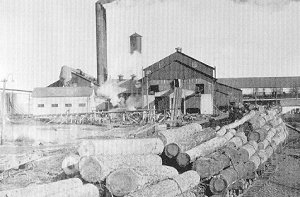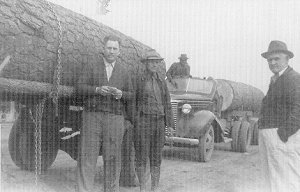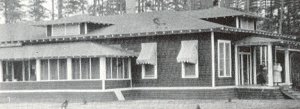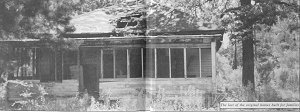
Kemper County MS GenWeb
Part of the USGenWeb
Electric Mills, MS
Submitted by Gene Allred
When the Sumter Lumber Co. moved from Sumter County, Alabama, and bought the Cochran and Harrington Lumber Co. at Bodka Station, four miles south of Scooba on the then Mobile and Ohio Railroad, all of its logging operations were in Southeast Kemper for over ten years. The camp, commissary and offices were about four miles east of Porterville. They used the roadbed of the old Mississippi, Gainesville and Tuscaloosa Railroad and Tram Road and built their own "dummy line" railroad on to their sawmill some six miles to the northwest. They also built railroads from Tamola to Kemper Springs and other parts of Southeast Kemper. As their logging progressed toward the northwest beyond Electric Mills they built dummy line railroads as far as their land holdings went, Oak Grove and almost to DeKalb.
The following article that was written in the mid-1930's in "Mississippi on Parade" and is in the files of the Mississippi Department of Archives and History, in Jackson, Mississippi, gives short summary of Electric Mills.
MISSISSIPPI'S LARGEST LUMBER OPERATION
SUMTER LUMBER COMPANY - ELECTRIC MILLS, MS
"When Sumter Lumber Company in 1912 moved from Sumter County, Alabama, where they had operated for some twelve years, to their present location, they built the first completely electrified mill in the country. Significant of this new idea in yellow pine sawmills, they names the town 'Electric Mills.' They built here as well one of the largest shortleaf mills in the United States; for years the largest single unit producer of shortleaf yellow pine in the world. The construction of this large plant was necessary on account of their extensive timber holdings, and throughout the twenty-eight years of operation they have cut their own timber, buying no logs on the outside. The timber owned by the company was all virgin shortleaf, of an unusually soft texture, close grained, running heavy to sap, practically free of pitch. The soft fiber, together with the white color, naturally led to the trademark of NEARWHITE, by which Sumter's product is known in the markets of the country.
While Electric Mills is owned in its entirety by the company, it is an incorporated town and a complete unit in itself. The company has provided a Club House, a Playground for the children, a Community House, which is the social center of the town and which houses over three thousand volumes of standard literature and current fiction; all of the late magazines are available in the reading room. A picture show in which the latest pictures are shown, as well as a very large and complete commissary, Ice Cream Parlor, and Ice Manufacturing plant, and other facilities such as found in any modern town. The Commissary carries a very complete stock of high quality merchandise, not only for the benefit of the employees, but likewise enjoys a quite heavy trade from the surrounding territory. Elementary schools for both white and colored are provided, as well as a Union Church.
Some twenty years ago the Company built for the benefit of their employees and their families, the George C. Hixon Memorial Hospital, a 52 bed hospital, with X-Ray room, Fracture Tables and all other equipment necessary for a complete modern institution of this kind.
The hospital is manned by a chief surgeon, assisted by two doctors, together with technician and some ten or eleven nurses and student nurses. While the primary purpose of the Hospital was for the Company's employees, the efficiency of the medical staff has made Electric Mills the medical center of the surrounding territory. With these and many special facilities offered the employees, and the very liberal wage scale which has always been maintained by Sumter, they have practically no labor turnover. Many of the employees have been with Sumter for from fifteen to twenty-five years and there are a number scattered throughout the crews who have worked continuously from thirty to thirty-five years.
All electricity being made from sawmill waste, and from electricity for home lighting being furnished to all employees, Electric Mills is often spoken of as the 'brightest town south of St. Louis.'"
The story of Electric Mills, Mississippi , Compiled by
Eva Mae May. No Copyright attached.
The Closing of the Sawmill in Electric Mills
By Wallace O'Neal
During the year, 1940, rumors were heard that the mill would close by the end of the year. As time passed, these rumors became facts. Mr. Temple had maps of all the land owned by Sumter Lumber Company. The maps were kept up-to-date by Mr. Temple marking off the cut-over land and showing the timber to be cut. As the time came closer, he would study these maps often to see just what was left to be cut. He and Hardy Myers spent considerable time on these maps, and it looked like all the timber would be cut by the end of 1940. Mr. Temple spent as much time as he could in the woods south of the mill where the company owned considerable land. The land had been cut over fifteen to twenty years before, but in that time, lots of timber had grown to nice saw-log size. Mr. temple advised Mr. Myers that there was much good saw timber grown back and suggested that he take a look at it. Mr. Myers did and agreed that it should be cut and brought into the mill. Hardy had Leon McCurley cruise this timber, and Leon found there were several million feet of good saw-timber. So it was decided to cut and bring the logs into the mill. This timber was eight to ten miles from the mill - too far to hauled with mules and oxen, so Hardy had Leon scout around over the country to see if he could find enough trucks to haul these logs to the mill. After a few weeks, he had enough truck contracts to do the job. It turned out that this timber extended the operation of the mill about three months. Instead of closing at the end of 1940, the time was extended to March 21,1941. Knowing the mill's day of operation would come to an end within a week or ten days, Hardy began to make arrangements for the final closing. One thing that I remember was that a man living near Scooba had a very large pine tree growing in his pasture. Mr. Myers asked him if he would sell the tree. They agreed on a price of $50.00, and Hardy had it cut into two very large logs. A truck was sent up and hauled the logs to the mill the morning the mill was closing. After all the other logs were cut into timbers, these two large logs were carried up the conveyor chine, and one put on each carriage. That being the last of the sawmill operation. Guy Cammack was sawyer on one rig, and Gavin Davis on the other rig. Therefore, they can be remembered as the two men who cut the last logs and closed the mill.
There were about seventy-five men out of work immediately. Everyone was, of course, very sad, as most of the men had worked there fifteen to twenty years, and a very few the entire life of the mill. Hardy made everyone feel a bit better when he announced that the company was going to give each employee a bonus of three-weeks pay as his job terminated. Mr. Temple and Joe West got busy and had the bonus money ready very quickly.
If this mill had to close, it came at a good time. It was during the war, and on the coast-mostly Pascagoula and Mobile-things were booming at the ship yards. Most of the men were skilled at their work. They fit nicely into the ship yard work. Most of them located there very soon-many of them with better jobs than they had at the mill.
There were about eighteen or twenty million feet of lumber on hand to be manufactured and sold. Therefore, the planer mill did not close until September, 1941.
The closing did not affect me as it did most of them, as I had been there only nine years and had been through the same thing at two or three other mills. There was just one thing to do. That was to get busy and get another job-which all of us did without too much delay.
Then, a few months later, the following notice in the paper.
ABOLISH TOWN OF ELECTRIC MILLS
The town of Electric Mills in Kemper County has been abolished by the proclamation of Gov. Paul Johnson, records in the Secretary of State's office showed Monday.
Governor Johnson asserted in the proclamation that since the Sumter Lumber Company moved its saw mill three months ago the town had less than 100 inhabitants, that the Board of Alderman has not held a meeting during the past six months, and that there are no bonds outstanding against the town.
It was over, the town was gone. In 1999 the last remaining house that the company built was destroyed.

Electrically driven sawmill of the Sumter Lumber Company Electric Mills.

The last logs from Electric Mills. Standing left to right: Robert Parker, Curtis Beazley and Jessie Baty.

George Hixon Memorial Hospital, Electric Mills, Mississippi

One of the beautiful shaded streets of comfortable homes in Electric Mills.

The last of the original homes built for families who lived in Electric Mills.
See 1930 Electric Mills Ball Team
From "Kemper County, Mississippi - A Pictorial History", placed here with permission by the Kemper County Historical Commission.
Questions or Comments?
If you have questions or problems with this site, email the County Coordinator, Marsha Bryant. Please to not ask for specfic research on your family. I am unable to do your personal research. I do not live in MS and do not have access to additional records.

